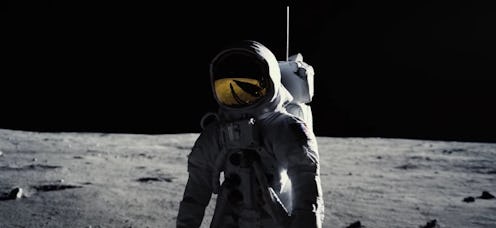Entertainment
The ‘First Man’ Visual Effects Will Make You Feel Like You’re Actually On The Moon
Even though the Oscars won't take place for over four months, the buzz about certain movies being contenders for the big ultimate film honor has already begun. One of the films igniting such chatter is Damien Chazelle's First Man, which comes out on Oct. 12 and stars Ryan Gosling as Neil Armstrong. As you can probably surmise from that description alone, the movie follows the lead-up to Apollo 11's trip to the moon and Armstrong's groundbreaking footsteps on it — literally. You definitely should see First Man in IMAX if you can because one of the most stunning aspects of the movie are the beautiful lunar sequences, which were filmed with IMAX high-resolution cameras, according to multiple sources.
According to IMAX's website, seeing First Man in IMAX theaters will allow audiences to see "up to 26% more picture on screen during the lunar landing." Once Armstrong and the Apollo 11's crew reach the moon, IMAX viewers will see even more of the gorgeous visuals of what it probably have looked like for Armstrong when he took that historical step onto the moon which the astronaut famously called, "one small step for a man, one giant leap for mankind." Since certain scenes of First Man were shot with IMAX cameras, it actually will make a difference which kind of theaters you see the movie in.
According to Forbes, regular movie theaters cut off the tops and bottoms of the screen during IMAX-filmed scenes. That's because the IMAX cameras use different aspect ratios than other cameras, and the IMAX version is less rectangular as it adds more height to the image.
Another benefit of seeing First Man in an IMAX theater is that the larger screen will make you feel more immersed in the vastness of outer space in the moon-landing scenes. It's a welcome reprieve from the movie's scenes taking place in rocket ships or spaceflight simulators as those are filmed with hand-held cameras inside such tight spaces that it's hard not to feel as claustrophobic and anxious as the astronauts must feel while hurling through the atmosphere. It's chaotic at time, but that just makes the eventual moon-landing feel all the more exhilarating.
In addition to using the IMAX cameras, director Chazelle also set First Man's cinematography apart by using LED screens rather than green screens, which Gosling mentioned during an appearance on a Chicago news broadcast. Canada's CBC confirmed that the usual green-screen effects were instead created with a 24 meter, 180-degree LED background.
Armstrong and the other actors playing astronauts attended real-live space camp for the movie, but Cory Stoll, who plays Buzz Aldrin in the movie, told CDC, "[filming] was an extension of that space camp in a sense," since the actors could see the LED screen around themselves, simulating outer space. "To look out the window and you see pretty much what we're seeing in the movie was incredible," Stall added.
No matter what type of movie theater screen on which you watch First Man, you'll still reap the benefits of its incredible visual effects, and even just from listening to the movie alone, you would probably feel incredibly inspired by it.
